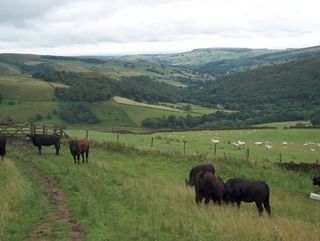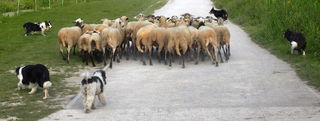Environment
Can Animals Predict Earthquakes?
A group of farm animals demonstrated more activity prior to earthquakes.
Posted January 30, 2020 Reviewed by Daniel Lyons M.A.

There have been reports of abnormal animal behavior prior to earthquakes since ancient times. The earliest reference might be from the Greek city of Helice in 373 B.C. Historians recorded that rats, snakes, weasels, and centipedes deserted the city and headed for safety several days before a devastating earthquake. Similar anecdotal accounts have come from around the world in the centuries since.
Martin Wikelski, of the Max Planck Institute of Animal Behaviour, says that the key to studying this phenomenon is our growing understanding of collective behavior in animals.
“What people call the ‘sixth sense’ of animals is an emergent property of sensing the environment and interacting – it’s nothing magical,” he says.
What’s more, new technologies mean that we can now measure what animals are doing 24/7 at very high resolution, enabling researchers like Wikelski to stringently test hypotheses about animals and earthquakes.
In a recent study, Wikelski and colleagues used continuous 3D-accelerometer data to remotely observe the activity levels of the animals (cows, dogs, and sheep) living on a farm near the epicenter of the destructive magnitude M6.6 Norcia, Italy, earthquake that occurred October-November 2016. The researchers first identified and quantified the normal daily activity patterns for the three animal species. Then they analyzed nearly six months of animal activity data in the context of ongoing seismic activity and studied the mutual influence of the three species on each other.

The researchers found consistent anticipatory activity among the farm animals prior to earthquakes. The animals repeatedly showed unusually high activity levels before earthquakes, with anticipation times (1-20 hours) negatively correlated with the distance from earthquake epicenters (5-28 km). In other words, the further away the earthquake, the shorter the animal warning time.
Notably, these reaction patterns were found only during the periods when the animals were in the stable and not when they were on the pasture. This implies the animals were more sensitive in closed buildings. Wikelski believes this is probably related to the general stress response of animals being magnified when they are in a contained space. In crowded situations, there could be a heightened stress response and it could spread between individuals more efficiently.
This study didn’t address exactly what the animals are sensing in the environment ahead of earthquakes. The finding that anticipation time depends inversely on the distance to the epicenter is consistent with a slow, diffusive process, possibly related to electrical changes in the air or gas released from the earth. Before a rupture occurs, enormous pressures cause underground rocks to emit ions into the air. Wikelski compares the result to the electromagnetic air that diffuses out before a major thunderstorm or tornado.

“If they sense this electrostatic air coming towards them, the dogs go crazy and it spreads among the animals, amplifying the signal. It’s almost like a stock market crash where nobody knows how it started but there were some signs that something was wrong and then everybody goes crazy,” says Wikelski.
Wikelski says this experiment is just the first step in trying to stimulate a research agenda. He wants to know more about what the precursors of earthquakes are and how individuals start to sense them, as well as how these interactions between animals work.
“So far, some people still think I’m odd for thinking animals can even sense the precursors of earthquakes,” he says. Nonetheless, “there is an enormous ‘bio-treasure’ of information contained in collective animal behavior. There could be enormous benefits to understanding collective behavior and applying it for the benefit of humankind.”
Facebook image: TorriPhoto/Shutterstock
References
Wikelski, M., Mueller, U., Scocco, P., Catorci, A., Desinov, L., Belyaev, M., Keim, D., Pohlmeier, W., Fechteler, G., and Mai, P. M. Potential short-term earthquake forecasting by farm-animal monitoring. bioRxiv 2020.01.19.911313; doi: https://doi.org/10.1101/2020.01.19.911313.


